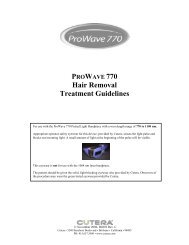Solar Lentigines Treatment Guidelines - Medsystems
Solar Lentigines Treatment Guidelines - Medsystems
Solar Lentigines Treatment Guidelines - Medsystems
Create successful ePaper yourself
Turn your PDF publications into a flip-book with our unique Google optimized e-Paper software.
LimeLight <strong>Treatment</strong> <strong>Guidelines</strong><br />
The following guidelines are based on physician feedback from treatments with the LimeLight Pulsed Light<br />
Handpiece on patients with Fitzpatrick skin types I–IV. <strong>Treatment</strong> of patients with skin type V and VI using the<br />
LimeLight Pulsed Light Handpiece is not recommended. Additional treatment information is discussed in the<br />
Clinical Presentations CD included with the system.<br />
The LimeLight should only be operated by qualified practitioners who have received appropriate training and have<br />
thoroughly read the operator manual. Protective eyewear must be worn by all people in the treatment room.<br />
Consult the Operator Manual for additional information, including contraindications and possible adverse effects.<br />
PRE-OPERATIVE CONSIDERATIONS:<br />
• Conduct a patient consultation complete with medical history prior to treatment.<br />
• Patients should not be treated if they have had significant sun exposure, or artificial (light based or sprayon)<br />
tanning, in the 4 weeks prior to treatment.<br />
• Clean the skin, including removal of all make-up and other skin care products. Any creams or products left<br />
on the skin can interact with the light and increase the risk of unwanted side effects.<br />
• Shave any hair in the area to be treated.<br />
• Pre-operative photographs should be taken with consistent technique (patient positioning, camera settings,<br />
and room lighting) prior to the initial treatment for general reference. Printed pre-operative photos can also<br />
be used to compare and duplicate the same patient position when taking follow-up photos.<br />
• Pigmented lesions should be evaluated for potential skin cancer warning signs prior to treatment. If these<br />
are present, the lesion should not be treated unless diagnosed as benign.<br />
• These treatments can be tolerated without anesthesia. Topical anesthesia can be used if desired. It must be<br />
completely removed prior to treatment. CAUTION: Toxicity may result with overuse of topical anesthesia.<br />
Consult the manufacturer's labeling.<br />
• When treating near the mouth, rolled-up gauze can be placed between the lips and teeth to protect the teeth<br />
from discomfort.<br />
• Although this device has not been optimized for hair removal, patients should be advised that hair removal<br />
may occur as a result of these treatments.<br />
• Do not treat over areas with tattoos.<br />
• Extreme caution should be used when treating near the eye, taking care to avoid ocular damage from the<br />
light. Patient eye protection appropriate for the given treatment should be used. The light should always be<br />
pointed away from the eye and only applied to the skin outside of the orbital rim. Skin at the edge of the<br />
orbital rim can be treated by pulling it away from the eye while simultaneously holding the goggles in<br />
place, so treatment is kept outside of the orbital rim.<br />
© November 2006, D0481 Rev. C LimeLight <strong>Treatment</strong> <strong>Guidelines</strong><br />
Page 2 of 4



